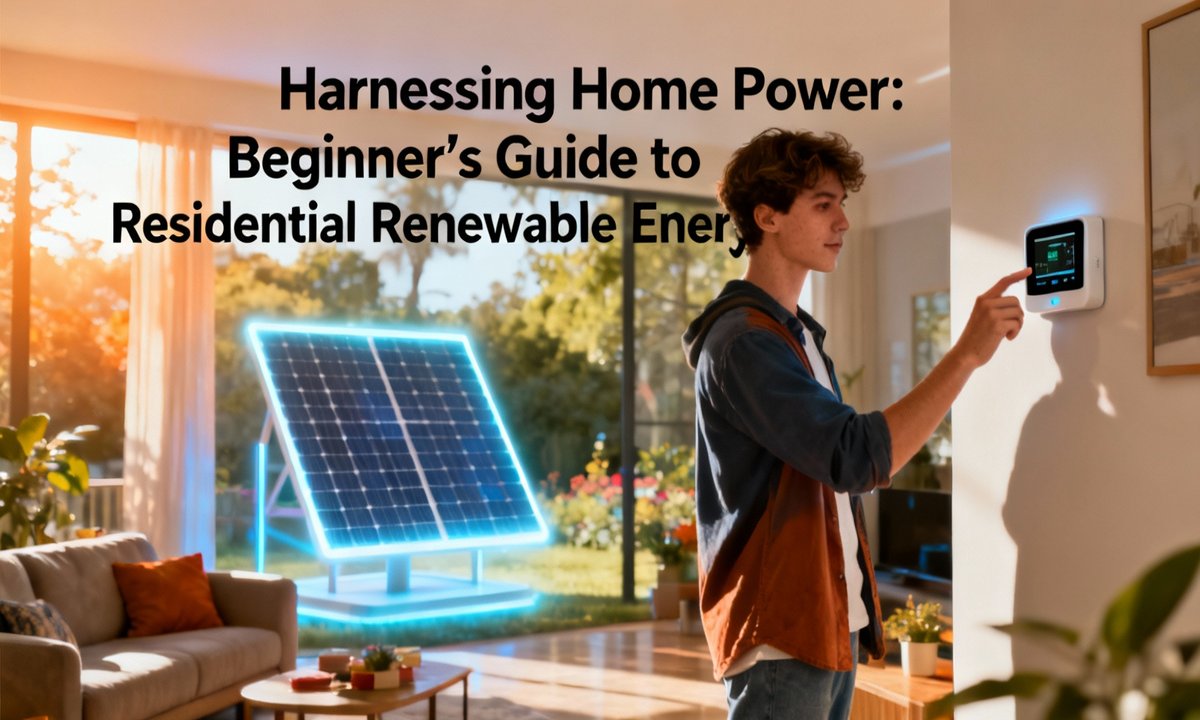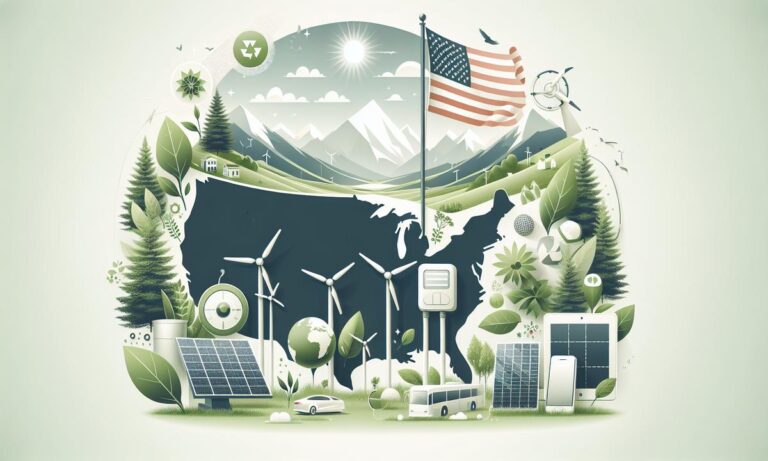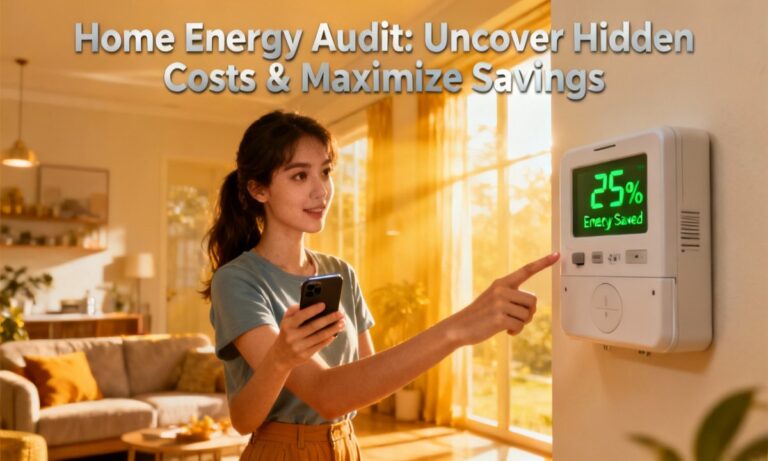Thinking about cutting your electric bill, shrinking your carbon footprint, and increasing your home’s value? Residential renewable energy solutions are more accessible than ever for homeowners in the United States. This guide introduces beginner-friendly options, what you need to know about costs, incentives, planning, and how to take your first steps toward sustainable living.
Embracing Home Renewable Energy Solutions
Switching to renewable energy at home means powering your life with clean sources like sunshine, wind, and the earth’s natural heat. By installing technologies such as residential solar panels or geothermal heat pumps, you can reduce utility bills, tap into financial savings, and support a healthier planet. Discover more about sustainable living practices.
What truly motivates U.S. homeowners to make this transition? First, rising utility costs make renewable energy options attractive for their long-term savings. Second, the environmental benefits of home renewable energy, like fewer emissions and improved air quality, make a real impact locally and globally.
If you are looking for smart ways to further lower your power bill, explore our article on reducing electricity costs with smart home upgrades. These modern solutions can complement your renewable energy journey, offering additional savings and efficiency for your household.
Popular Renewable Energy Options for Your Home
Homeowners today can select from several proven renewable energy solutions tailored to diverse needs. These systems offer distinct advantages depending on your location, climate, and household requirements. Choosing the right one is key to maximizing benefits.
Understanding Different Residential Renewable Systems
Solar Photovoltaic (PV): These roof- or ground-mounted solar panels for home use are the most widely adopted across the U.S. They are simple to install, require little maintenance, and are effective in most states. Find out more about residential renewable energy systems types and benefits.
Solar Water Heating: Systems utilize sunlight to heat water, efficiently covering up to 70% of hot water needs. This is achieved through roof collectors and specialized storage tanks, significantly reducing conventional heating costs.
Micro Wind Turbines: These compact turbines, mounted on roofs or in yards, generate electricity. They are designed for homes, even those with smaller yards or property limits, providing an alternative clean power source.
Geothermal Heat Pumps: Harnessing the earth’s steady underground temperature, these systems provide year-round heating, cooling, and hot water. They function like a natural HVAC system, offering significant energy efficiency. Learn more about residential renewable energy options.
Biomass Systems: Burning organic materials such as wood or pellets for heat or power is a viable option. This method is particularly sensible for properties located in rural settings, offering a renewable fuel source.
Hydropower: While a niche solution, this option works well for homes situated near flowing water. It can provide a reliable, always-on power source, especially in suitable geographical locations. Not every option fits every home, but solutions are increasingly matched to your region.
How Solar Energy Powers Your Home
Solar energy for beginners involves understanding the process of converting sunlight into usable electricity for your household. This straightforward technology captures abundant energy from the sun with minimal oversight once installed.
The Basic Mechanics of Solar Power
Solar panels (PV modules) installed on your roof actively capture sunlight throughout the day. This captured energy is then converted into direct current (DC) electricity, which is not immediately usable by most home appliances.
An inverter plays a crucial role by changing the direct current (DC) into alternating current (AC). This AC electricity is what powers your household appliances and lighting, seamlessly integrating into your daily life.
Any excess electricity generated can either be stored in batteries, providing valuable solar battery storage for later use. Alternatively, it can be sent back to the electrical grid if your utility offers net metering, potentially earning you credits.
Curious about how solar panels work and why they are a leading renewable energy solution for homes? Think of them as silent technology, harnessing energy every sunny hour. The solar panel installation process is now easier than ever, thanks to equipment advancements and simplified permitting.
Solar Power’s Rapid Growth in the U.S.
As of 2024, the United States boasts an impressive 220 GW of installed solar PV capacity. This significant growth underscores the country’s commitment to clean energy and the increasing adoption of solar technology by homeowners and businesses alike. Learn more about clean energy progress in the United States.
Residential renewables now contribute approximately 9.1% of the total U.S. energy supply. Within this sector, solar energy stands out as the fastest-growing segment, highlighting its rising popularity and accessibility for homes across the nation. Explore the U.S. renewable energy factsheet.
Costs, Savings, and Incentives for Homeowners in the United States
The cost of residential solar panels in the USA has seen a dramatic decrease, making solar and other renewables more affordable for homeowners. Initial installation prices can typically range from $8,000 to $25,000 for a standard home, often after various rebates and incentives are applied.
Key Financial Incentives for Renewable Energy
1. Federal Tax Credit: The Residential Clean Energy Credit allows you to deduct 30% of your system cost from federal taxes. This applies to installations including solar, wind, geothermal, and batteries through 2032. Review IRS details for comprehensive information.
2. State and Local Incentives: It is advisable to check with your specific state energy office. Many states offer additional rebates, property tax exemptions, or performance-based incentives that can further reduce your costs and increase savings.
3. Net Metering: If your utility provider offers net metering, you can sell any unused electricity generated by your system back to the grid. This process can significantly lower your monthly utility bills, adding to your overall financial benefits.
For solar incentives in the USA, always double-check eligibility and deadlines, as policies can shift. Learning practical ways to save thousands with frugal living can amplify your energy savings, making your investment even more impactful.
Understanding Typical Savings
Homeowners who install a properly sized renewable energy system may observe a substantial reduction in their annual electricity costs. These savings often range from 30% to 70%, contributing significantly to long-term financial stability.
While battery storage adds an initial cost to your system, it greatly increases your energy independence. This means you have a backup power supply and can use stored energy during peak times, further optimizing your electricity usage.
Planning & Installation: Essential Information for Homeowners
Embarking on a renewable energy project requires careful planning, but each step is an investment that pays off over time. Understanding what’s involved ensures a smoother installation process and optimal system performance.
Analyzing Your Current Energy Consumption
Start by closely examining your current utility bills. Understand how much power you consume and identify peak usage times. Online calculators can help estimate the appropriate system size and project the payback time for your future investment. Most utility companies or state energy offices provide helpful tools for this analysis.
Assessing Site Suitability for Installation
For solar installations, consider if your roof is shaded and its orientation. A south-facing, unshaded roof is ideal, but east and west-facing roofs can also be effective.
If you’re considering wind power, evaluate if there is enough open, breezy space near your home. Consistent wind exposure is crucial for efficient turbine operation.
For geothermal systems, assess your yard size and soil type. These factors are important for determining the feasibility and design of the underground loop system.
Navigating Permitting and Regulatory Requirements
It is essential to obtain all required permits, including building, electrical, and zoning approvals, before starting your project. This ensures compliance with local regulations and safety standards.
Ensure that all your equipment is certified and fully meets the requirements of the National Electrical Code. This step is vital for safety and system longevity.
If your system will connect to the grid, secure utility approval and possibly an interconnection or net metering agreement. This ensures smooth operation and allows you to benefit from selling excess power. Refer to the DOE planning guide for home renewable energy systems.
If you’re thinking about energy-proofing your home for cold weather, combining renewables with insulation upgrades can lead to maximum efficiency. This integrated approach enhances comfort and delivers even greater energy savings.
Practical Steps for Homeowners: Your Renewable Journey
Ready to transition to renewable energy? Here’s a step-by-step guide for beginners on how to approach home solar and other green power options effectively. Each step is designed to make your journey straightforward.
Getting Started with Your Renewable Energy Project
1. Research Eligibility: Utilize your state energy office or trusted sources like the DOE to check local rules, available incentives, and identify nearby certified installers. This initial research is critical.
2. Get Multiple Quotes: Compare proposals from several certified professionals. Evaluate costs, warranty options, and always factor in potential maintenance and ongoing service plans to make an informed decision.
3. Evaluate Financing: Many homeowners choose various financing options such as loans, leases, or power purchase agreements (PPAs) to manage and spread out the initial costs. Explore what works best for your budget.
4. Install and Connect: Whether you opt for a DIY approach or professional installation, ensure all inspections and code compliance are met. This is crucial for safety, system performance, and securing any applicable rebates.
5. Monitor Your Energy: Many modern renewable energy systems offer real-time monitoring capabilities. This allows you to track your energy production, observe your savings, and effectively manage your overall usage patterns.
If a full installation isn’t feasible at your location, research community solar and green power programs. These options allow you to benefit from renewables through your utility, supporting clean energy goals without on-site installation.
For more insights on eco-friendly home products and sustainable living practices, check out our in-depth guide. Discover practical ways to enhance your home’s environmental footprint.
Choosing Between Professional Installation and DIY for Solar Panels
Deciding whether to call the professionals or embark on a do-it-yourself solar installation depends on several factors, including your comfort with electrical work and project management. Both routes have distinct advantages and considerations.
Benefits of Professional Installation
Opting for professional installation typically results in a quicker process with fewer potential headaches. This approach is often essential for complicated setups or larger systems, ensuring proper integration and performance.
Certified installers possess expert knowledge of permits, electrical standards, and warranty paperwork, streamlining the entire project. While there is a higher up-front cost, it usually covers comprehensive service and ongoing support.
Considerations for DIY Solar Panels
DIY solar panels can offer lower up-front costs, especially if you are adept with tools and comfortable with electrical work. This route appeals to those seeking maximum control over their project budget.
This option is ideal for off-grid cabins, sheds, or supplemental systems where complexity is lower. However, you will be responsible for managing all permitting, ensuring safety, and arranging for long-term support yourself.
The Far-Reaching Benefits of Home Renewables
The advantages of embracing renewable energy for home use extend far beyond mere financial savings. These benefits encompass significant environmental improvements and broader economic contributions, impacting both your household and the community.
Environmental Impact of Clean Energy
By integrating clean energy solutions, you can significantly lower your home’s carbon footprint. This conscious choice contributes to improved local air quality, fostering a healthier environment for everyone. Explore more on residential renewable energy systems types and benefits.
Economic Advantages for Homeowners and Community
In addition to substantial energy bill reductions, homes equipped with renewable systems often experience an increase in resale value. Furthermore, these systems provide a valuable insulation from the volatility of fossil fuel price swings.
By adopting renewables, you are actively supporting national clean energy goals. This collective effort helps to create a more reliable and resilient energy system for all, benefiting the entire community.
Frequently Asked Questions: Home Renewable Energy in the U.S.
How do I know if my home is a good candidate for solar?
A south-facing or unshaded roof maximizes solar production, making it an ideal candidate for solar panels. However, east- and west-facing roofs can also work effectively. Use our site checklist and online calculators for the most accurate estimate.
How much can I really save with home renewables?
Most homeowners can expect to reduce their electricity costs by 30–70% over a system’s lifetime. Those residing in sunnier regions often experience faster paybacks, with the best home renewable energy systems paying for themselves in as little as 5–8 years.
What’s the difference between grid-tied and off-grid systems?
Grid-tied setups operate in conjunction with your utility provider, allowing you to send excess power back for credit or use the grid as a backup. Off-grid systems, conversely, provide total energy independence but necessitate larger battery systems for storage.
Can I add battery storage later to my solar system?
Yes, absolutely! Many homeowners strategically choose to begin with solar panels for home and then opt to add battery storage later. This decision is often made as battery prices become more affordable or as the need for backup power becomes more attractive.
How do the federal solar energy tax credits work?
The federal solar energy tax credits 2025 enable you to deduct 30% of your installation costs directly from your federal taxes. If your credit amount exceeds what you owe, you have the flexibility to roll the remaining balance into future tax years. Find more details from the IRS.
Where can I find more resources and green living inspiration?
Explore sustainable living practices, discover budget-friendly home upgrades, or learn additional smart home energy efficiency tips across our site. We offer a wealth of information to help you on your journey towards a greener lifestyle.
Embracing residential renewable energy is a practical, empowering path for U.S. homeowners. With falling costs, robust financial incentives, and global climate goals, now is an opportune time to take control of your energy destiny—one clean kilowatt at a time.




